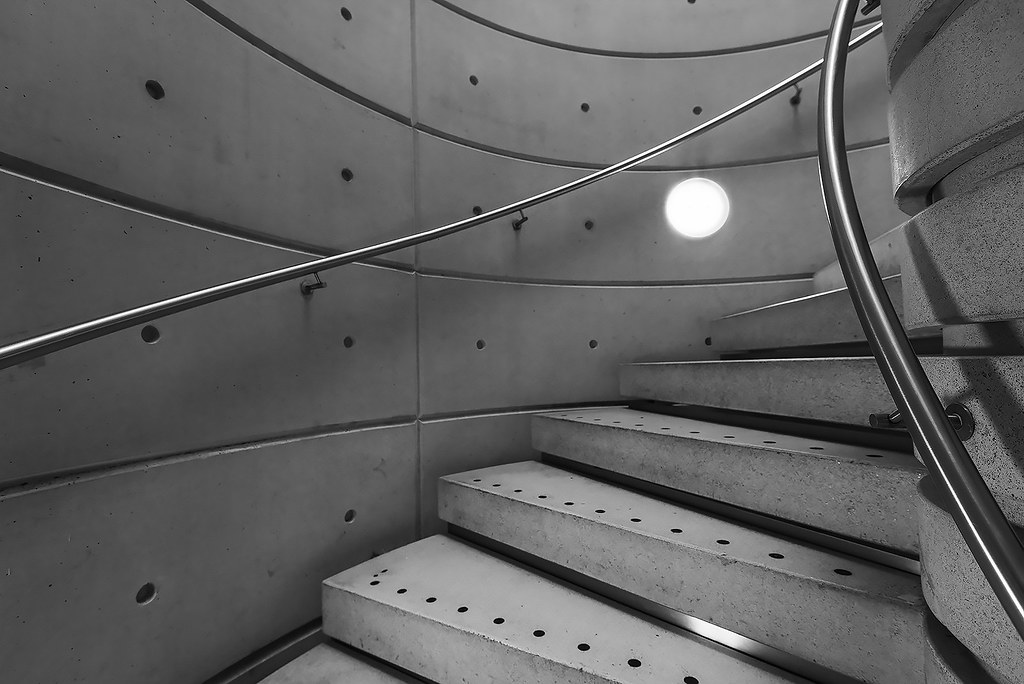I walked down those interesting stairs yesterday evening! I went to listen to a fascinating lecture by Simon Baker, Senior Curator of Photography at the Tate, about his apparently successful efforts over the last 8 years to turn the Tate round from regarding photography as a craft, more appropriate to the V&A, to a fully fledged Art. I was impressed enough that I will probably make the effort to visit his next exhibition of photography at the Tate in May 2018.
http://www.tate.org.uk/whats-on/tate-modern/exhibition/light-photography-and-abstract-art
Your impressive first shot, which very well captures the feel of this rather steeply curved (and long) staircase is also technically interesting, because you shot it with the Samyang Tilt-Shift, which I understand is a rectilinear perspective lens (i.e. straight lines in the world end up as straight lines in the image), but as 3 shot pano. The pano stitching has transformed the perspective projection into fisheye in the vertical direction, which is the longest, but has retained linearity in the horizontal direction. Was that a decision which the stitcher you used took on its own initiative, or did you request it?
You say "there is some distortion in these but I quite like it". I would argue that there is no distortion in any of those shots, in the sense of distortion which is introduced by some defect of the camera or lens. The apparent distortion of the last two shots, in which all straight lines in the staircase are straight lines in the image, was shot with a good wide angle lens which is intended to produce the kind of perspective projection known as linear or rectilinear, which it does. It looks unnatural merely because the angle of view of the camera is wider than the angle of view of the eye when looking at the image from a normal viewing distance.
If you shut one eye, centre the open eye over the middle of the image, and then move the eye closer to the centre of the image, there will come a point where the eye's angle of view is the same as that captured by the camera. At that point it will no longer look unnatural. In other words, the apparent distortion is created by looking at the image from an inappropriate distance. It's not the fault of the lens. It's a fact of the geometry of perspective projection. Calling it distortion suggests that it could be corrected by a better lens or some kind of post processing. But it can't. It's a fact of life, an inescapable feature of trying to represent the appearance of a 3D world on a flat piece of paper. That's why I don't like calling it "distortion".
Rectilinear perspective projection, the kind used by most camera lenses, is only one way of projecting the 3D world onto a flat piece of paper. Fisheye projection, which preserves viewing angles at the cost of bending straight lines, is another. Cylindrical projection, which does fisheye along the longest axis of the image, and rectlinear on the other, is often employed for wide panoramic views.
I see this comment has turned into a lecture. That's a bad habit I'm trying to give up since I retired from being paid to lecture. I'll leave it here in case it's interesting for some people.
Thanks for the interesting photographs which inspired this over long comment!
 Museum Steps by Simon Wootton, on Flickr
Museum Steps by Simon Wootton, on Flickr Museum Steps by Simon Wootton, on Flickr
Museum Steps by Simon Wootton, on Flickr Museum Steps by Simon Wootton, on Flickr
Museum Steps by Simon Wootton, on Flickr Museum Steps by Simon Wootton, on Flickr
Museum Steps by Simon Wootton, on Flickr Museum Steps by Simon Wootton, on Flickr
Museum Steps by Simon Wootton, on Flickr Museum Steps by Simon Wootton, on Flickr
Museum Steps by Simon Wootton, on Flickr
